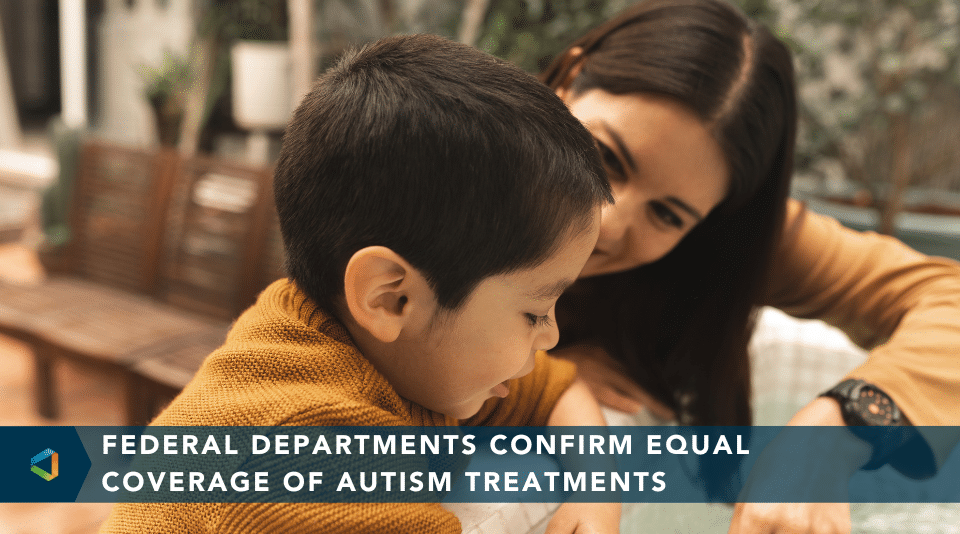Compliance Confidence
Mental Health Parity Compliance: The DOL’s April 2, 2021 FAQs and Conducting Comparative Analyses
Mental Health Parity Compliance: The DOL’s April 2, 2021 FAQs and Conducting Comparative Analyses
Last December’s Consolidated Appropriations Act (CAA) included an amendment to the Mental Health Parity and Addiction Equity Act (MHPAEA).
Starting February 10, 2021, group health plans subject to MHPAEA must perform and record a “Comparative Analysis” of the non-quantitative treatment limitations (NQTLs) imposed on covered mental health and substance use disorder benefits (MH/SUD).
The Departments of Labor, Health and Human Services and Treasury (collectively, the Departments) have issued regulations and guidance on MHPAEA numerous times since 2008. For the Departments’ April 2, 2021 FAQ on the new Comparative Analysis requirement, click here.
MHPAEA enforcement has long been a challenge. One particularly slippery concept pertains to detecting NQTLs and ensuring compliance. This is partly because NQTLs relate to the inner workings of claims administration with coverage guidelines which may lead to MH/SUD claims being reviewed more frequently or restrictively than medical/surgical claims. NQTLs are, in simplest terms, limitations on benefits that cannot be expressed numerically.
A typical NQTL may be a coverage guideline under which claims for inpatient mental health treatment are reviewed more harshly than the guidelines under which claims for inpatient medical treatment are reviewed. Unlike many quantitative treatment limitations (or QTLs) found in comparing benefits like the maximum number of outpatient visits per plan year, the NQTL Comparative Analysis requires information that may not be readily available.
While plan participants are entitled to request information about NQTLs under MHPAEA and ERISA, these individuals are not in a good position to appraise a plan’s response. Participant requests are often spurred by a claim denial. By the time the plan responds, the information may no longer be useful to respond to a time-sensitive denial of treatment. Participants may also be uninformed on how to report violations.
What’s Required?
Indicating that general statements of compliance and broadly stated processes are insufficient, the Departments have instructed a minimum nine elements required in the Comparative Analysis:
- A clear description of the specific NQTL, plan terms, and policies at issue.
- Identification of the specific MH/SUD and medical/surgical benefits to which the NQTL applies within each benefit classification, and a clear statement as to which benefits identified are treated as MH/SUD and which are treated as medical/surgical
- Identification of any factors, evidentiary standards or sources, or strategies or processes considered in the design or application of the NQTL and in determining which benefits, including both MH/SUD benefits and medical/surgical benefits, are subject to the NQTL. Analyses should explain whether any factors were given more weight than others and the reason(s) for doing so, including an evaluation of any specific data used in the determination
- To the extent the plan or issuer defines any of the factors, evidentiary standards, strategies, or processes in a quantitative manner, it must include the precise definitions used and any supporting sources
- The analyses, as documented, should explain whether there is any variation in the application of a guideline or standard used by the plan or issuer between MH/SUD and medical/surgical benefits and, if so, describe the process and factors used for establishing that variation
- If the application of the NQTL turns on specific decisions in administration of the benefits, the plan or issuer should identify the nature of the decisions, the decision maker(s), the timing of the decisions, and the qualifications of the decision maker(s)
- If the plan’s or issuer’s analyses rely upon any experts, the analyses, as documented, should include an assessment of each expert’s qualifications and the extent to which the plan or issuer ultimately relied upon each expert’s evaluations in setting recommendations regarding both MH/SUD and medical/surgical benefits.
- A reasoned discussion of the plan’s or issuer’s findings and conclusions as to the comparability of the processes, strategies, evidentiary standards, factors, and sources identified above within each affected classification, and their relative stringency, both as applied and as written. This discussion should include citations to any specific evidence considered and any results of analyses indicating that the plan or coverage is or is not in compliance with MHPAEA
- The date of the analyses and the name, title, and position of the person or persons who performed or participated in the comparative analyses.
Going Further
The CAA directs the Departments to audit the Comparative Analyses of at least 20 plans each year. While the risk of audit is low, there is no doubt that full access to mental health benefits is good for employers and employees alike. Employers should consider embracing this opportunity to advance transparency in NQTLs, going beyond the Departments’ minimum requirements, especially if parity concerns have been raised by their employees. Transparency will enable the DOL to identify where additional guidance may be needed and where MHPAEA investigations should be properly directed. The Departments have indicated they expect to focus on NQTLs related to prior authorization requirements, concurrent reviews, provider admission into a network, and reimbursement rates, both in- and out-of-network.
In addition to the minimum nine elements listed in the Departments’ latest guidance on Comparative Analysis, employers may want to look at the Department of Labor’s MHPAEA Self-Compliance Tool. One snag in the Departments’ guidance is the apparent assumption that NQTLs have already been identified.
For employers to gain a better understanding of how plans are self-checking parity compliance, they may want to ask for the following information in addition to the nine minimum requirements:
- List of NQTLs the plan is considering in its Comparative Analysis;
- Samples of approvals and denials of MH/SUD and medical/surgical benefit claims at each comparable level of care (prescription drugs, outpatient, intermediate, inpatient, and emergency care), both in-network and out-of-network;
- List of any exclusions on specific treatments or billing codes;
- Processes for evaluating parity compliance in the application of medical necessity guidelines and plan exclusions (i.e., custodial care) to MH/SUD and medical/surgical claims, including the qualifications of those evaluating the comparable evidentiary standards; and
- Copies of reports to applicable state parity enforcement agencies.
Asking for additional information is a strong showing of MHPAEA compliance efforts. And, where these requests relate to a plan’s decision-making process, a plan’s responses may help employers anticipate their employees’ complaints related to MH/SUD benefits decisions.




